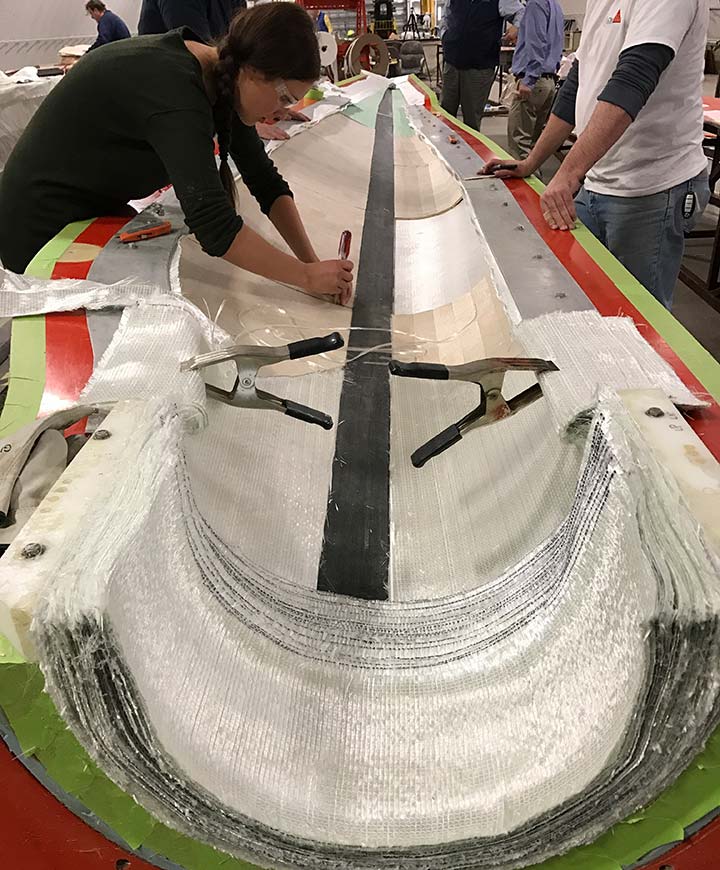Greening Industry: Building Recyclable, Next-Generation Turbine Blades
We have come a long way since the first Earth Day in 1970.
As of January this year, there were nearly 1.5 million electric cars driving on U.S. roads, we recycle and/or compost approximately 35% of our waste (Environmental Protection Agency), and roughly 20% of U.S. energy generation comes from renewable sources (U.S. Energy Information Administration).
According to the American Wind Energy Association, wind energy generation has grown by 7.3 gigawatts (GW) of installed capacity for every year of the last decade. And, as of 2019, there was approximately 96 GW of installed wind capacity in the United States and 591 GW worldwide.1
While the expansion of renewables is undoubtedly a positive shift, not all renewable energy is renewable from start to finish.

A recent Bloomberg News article stoked concern by shining a spotlight on Casper, Wyoming, home to a graveyard for nearly 900 wind turbine blades.
Casper’s municipal landfill serves as a final resting place for spent blades, the volume of which has been growing exponentially as wind energy’s robust expansion continues. The article suggested that over the next four years alone, the United States will decommission more than 8,000 blades.
While other parts of the wind turbine can be reused or recycled, blades as they are currently constructed cannot be. A study found that each megawatt of installed capacity equates to 9.6 metric tons of composite waste.2
This poses a significant challenge at the end-of-life stage of the blades—both environmentally and economically.
As the collection of decommissioned blades multiplies, it begs the question: Where will they go?
Building a Better Blade
NREL researchers and their partners saw an opportunity within the challenge.
Tapping into a vast wealth of experience in fundamental wind energy research, development, and validation, NREL researchers established an approach to manufacturing wind turbine blades, employing a thermoplastic resin system developed by Arkema Inc.
The thermoplastic resin system is a potentially groundbreaking development because it allows the turbine blades to be recycled at their end of life.
And it is not just the recyclability that sets these next-gen blades apart.
A Potential Game Changer
“Employing a thermoplastic resin system, including thermal welding, is the answer for building longer, lower cost, recyclable wind turbine blades,” explained NREL researcher Robynne Murray.
“It’s the ability to use this infusible thermoplastic in the same processes that are currently used by blade manufacturers that makes this resin different from other thermoplastics that are widely used in other industries,” Murray said.
These thermoplastic resins enable a manufacturing process that allows wind turbine blades to be recycled at their end of life and also reduces the time, cost, and energy involved in manufacturing.
The principal drivers of blade cost are the materials and direct labor.
Thermoplastic blade production allows for a reduction in labor costs due to its faster curing cycle compared to the thermoset resin/epoxy.
Also, because thermoplastics do not require heat to cure, equipment and labor costs are lower than they would be for the business-as-usual epoxy blade in which heated tooling or a post-curing oven would be required.
Moreover, thermoplastic blades can be thermally joined, instead of relying upon adhesive bonds. Blades can potentially be made stronger and lighter, and they can also be more easily repaired compared to the business-as-usual blade.
The thermoplastic resin system paves the way for the on-site manufacture of blades so that larger blades can be built at much lower transportation costs.
And, as though these reasons were not proof enough of the value of thermoplastics and thermal welding, these blades also perform well when saturated with seawater, opening the door for countless marine energy applications.
Getting Their Sea Legs
Marine energy is the wave of the future, so to speak, though thermoplastic composites have yet to be validated at a full scale and in realistic, submerged operating conditions.
NREL researchers are working to change this.
NREL is one of a few laboratories with the capacity and capabilities to manufacture full-scale blades for use in such environments and applications.
Researchers can produce the composite blades at the Composites Manufacturing Education and Technology facility and perform full-scale structural validation on the blades at NREL’s Structural Technology Laboratory.
As wind energy continues its meteoric rise and the marine energy industry gets its feet wet, it is essential that turbine life cycle remains front and center of these industries, lest they fall prey to unintended consequences, such as tons upon tons of turbine trash.
Collaborating with industry partners, NREL researchers are working to bring these innovative, recyclable blades and processes to market.
NREL’s pioneering thermoplastics work is helping to close the circle, ensuring that today’s blades become tomorrow’s blades, too.
Learn more about NREL’s work in Advanced Thermoplastic Resins for Manufacturing Wind Turbine Blades, Advanced Manufacturing, and Wind Energy.
Last Updated May 28, 2025
